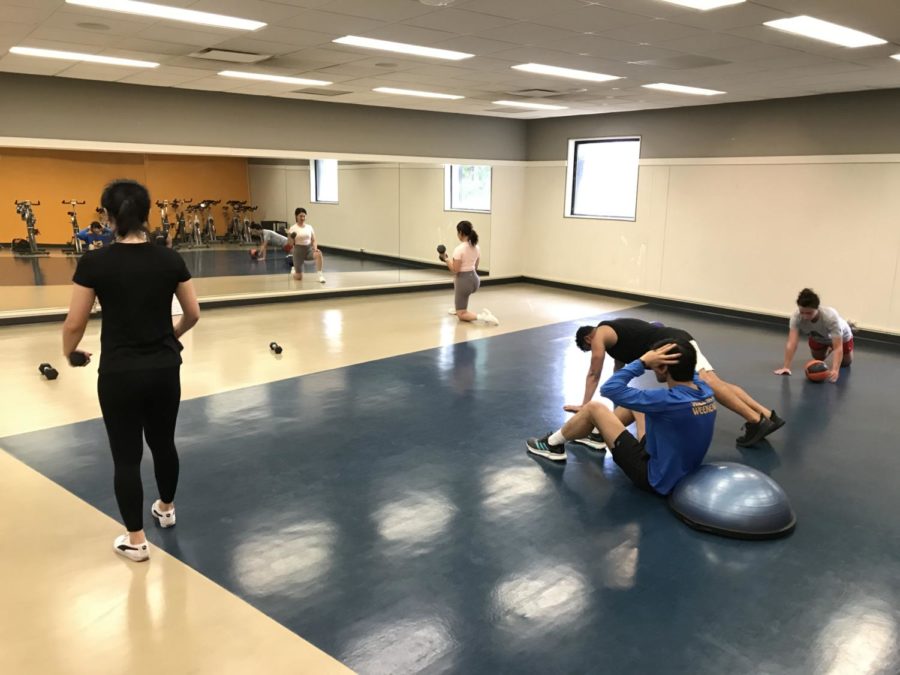Sports Performance Is Not Just for Athletes
October 18, 2022
The Sports Performance Group Fitness Class takes place Tuesdays and Thursdays from 10:30 to 11:30 a.m. and Fridays from 10 to 11 a.m. in the P.E. Complex.
The group fitness class is instructed by two studious individuals of exercise science, Fitness and Wellness Graduate Assistant, Talli Shepherd, and Aquatics Coordinator, Mac Varilla. As Shepherd and Varilla put it, “we work together to co-teach and use teamwork.”
After some observation, it is easily noticeable that Shepherd’s teaching style is vocalizing the desired movements of the participants and enunciating loudly and clearly. Shepherd admits to being the “puppet master” while instructing the class, and Varilla acknowledges that he does the demonstrations, sort of like a “crash test dummy.” Shepherd is a very vocal instructor, while Varilla is the demonstrator, and they make a really great team for a novel and refreshing experience.
Sports performance can take many forms of physical and kinesthetic activities. Before beginning any sporty or physical workout, it is imperative to understand one’s bodily limitations in terms of strength, speed and agility because it would feel unpleasant and uncomfortable to overwork any muscle group. With that said, sports performance is simply the practice of training the body to enhance pre-existing muscularity, swiftness and dexterity.
The class intends to be a gathering in which people train in unison with like minded individuals. Doing a routine workout individually in a weight room sometimes gets dull, repetitive, dreary and humdrum. It is venturous to stay nimble and get out of one’s comfort zone.
Photo credits by Ananth Prabhu
Photo Caption: Varilla is pictured on the right by demonstrating an activity. Hussaini is pictured in the center on a semi-spherical ball, or Bosu ball, practicing his posture and abdominal crunches activity.
According to the instructors a conventional sports performance fitness class gives more importance to quantity over quality with repetitions of the same activities, however, Shepherd and Varilla disclosed that they pay particular attention to quality over quantity by organizing plenty of activities to do in a single hour.
For example, the instructors said that “instead of just burning more calories,” which is a quantitative variable, they focus on the usefulness of qualitative variables “for sport, daily mobility [and] activities.”
Shepherd and Varilla have stated that “mostly students show up, but [the class] is very open to community members too.” The class times sometimes change to encourage more involvement from a greater variety of students and an increasing number of community members.
Nateen Hussaini, a graduate student in mathematics, participates in the group fitness class. “I like the combination of speed [and] explosiveness, mobility, strengths, calisthenics and weights.” Hussaini says, “I get to push myself even more” than in the weight room, and it is “good [to gain] experience and [great] for athletes too.”
The sports performance class includes a variety of stations where the participants rotate through. Some stations involve flexing weights in various bodily positions. Other stations rely on hovering the feet while bumping a medicine ball from side to side.
Some stations allow participants to run rapidly while meandering cones like in an obstacle course. There may be some forwards sprinting, backwards walking and sideways shuffling involved in side-by-side relay races. Activities vary greatly between each station to keep it fresh.
For example, you may find some posture exercises, such as planking while transitioning from elbows to palms and back again. You must also keep your spine straight while doing it. You may also find yourself using a semi-spherical ball, or Bosu ball, to lie upon and do abdominal crunches. The participants’ postural muscles, quadriceps and hamstrings end up getting flexed, extended and stabilized in the great variety of exercise stations in the class.
Photo credits by Ananth Prabhu
Photo Caption: Sports Performance Group Fitness Class participants are in their stations doing various physical activities, and they will be rotating through to adjacent stations.
Getting into a new routine and creating new habits is usually a challenge for most people, but it is possible. Hussaini has already taken part in the sports performance class six times since the semester began. You could say that Hussaini is already dedicated to the sports performance class, and he encourages other students and community members to join by saying that he enjoys the “team practice.”
Hussaini said that his “favorite [activity] is strength-training because [he already does] it in the weight room” as well, and it is what Hussaini is accustomed to doing.
When it comes to new activities, it is a normal condition for humans to seek novel experiences, and Hussaini is no different because he has insisted that physical movements, like combinations, are new for him.
He also said “I enjoy the uniqueness of speed and box jumping because it is unique to the class!” Box jumping is when there is a wooden box of varying size in front of a participant, and the participant must jump up with both feet in unison to the height of the box and stand on top of the box, and then jump backwards back to the floor with both feet in unison.
No exercise practice is complete without first establishing goals. Based on prior experience of each individual, it is imperative to create some type of incredibly ambitious or slightly ambitious physical activity goals before exercising. Hussaini has done just that because he says, “I want to be more well-rounded, I also do rock-climbing, [and] I am thinking about doing flag football and pickleball” at some point.
As participants have goals, so do the instructors. Shepherd and Varilla agreed that “our goals are to progress, stay consistent and [evaluate] our progress over time” while keeping a homogenous rhythm “by coming back every single week.”
Last but certainly not least, Hussaini admits that the “music [choice] is good.” When doing any physical activity, it is important to seek motivation whether from a fitness instructor or from the music playing in the background.
In anthropology and sociology, there is a concept known as participant observation. It is imperative to use this unique perspective in lifestyle activities that may be new to you. By doing such ritualistic behavior, such as participating in a fitness class, you would be able to meet new people, learn about other people, and indulge yourself into new life experiences. Participant observation is an excellent technique to change your routine and do something different while also learning new skills and applying them to your fitness goals. Thus, this particular Sports Performance Group Fitness Class at the P.E. Complex is an excellent way to achieve new experiential knowledge.
The class was much more diverse from my usual routine of working out with traditional free weights, targeted weight machines, using cardiovascular equipment and shooting baskets. I personally agree with Hussaini that taking part in a class of this caliber can definitely improve an individual’s fitness regimen and spice up one’s workout routine. I would definitely be willing to do it again in the future, and I encourage all of you to join me as well. So come out, be a participant observer and venture into some new experiences with me!









